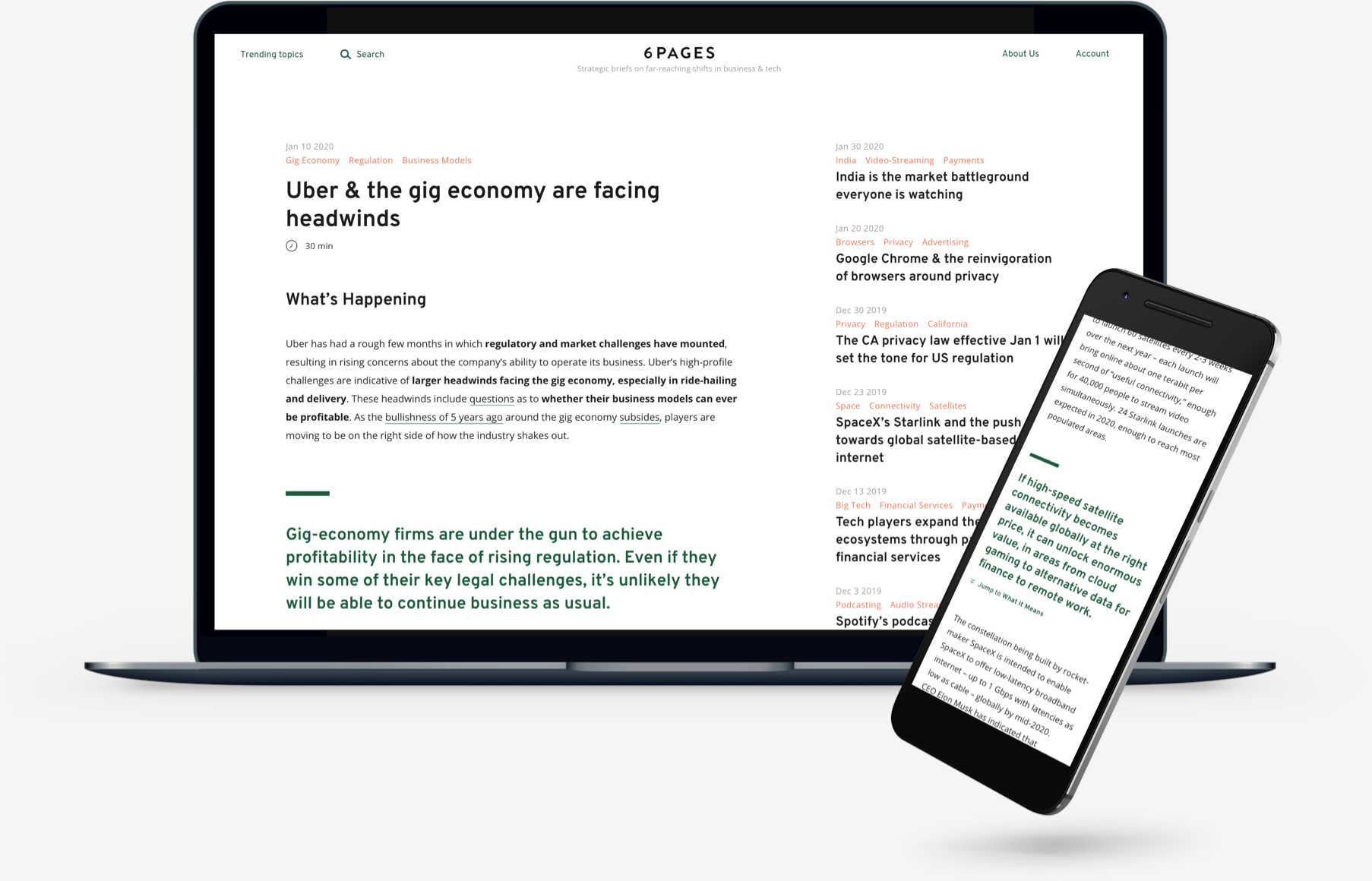“
6Pages write-ups are some of the most comprehensive and insightful I’ve come across – they lay out a path to the future that businesses need to pay attention to.
— Head of Deloitte Pixel
“
At 500 Startups, we’ve found 6Pages briefs to be super helpful in staying smart on a wide range of key issues and shaping discussions with founders and partners.
— Thomas Jeng, Director of Innovation & Partnerships, 500 Startups
“
6Pages is a fantastic source for quickly gaining a deep understanding of a topic. I use their briefs for driving conversations with industry players.
— Associate Investment Director, Cambridge Associates
Read by

Used at top MBA programs including
Oct 31 2025
11 min read
1. All of these white-collar layoffs
- This past month has seen a steady stream of white-collar layoff announcements from companies like Amazon, Meta, Alphabet-owned YouTube, Goldman Sachs, UPS, Chegg, Accenture, Target, Carter’s, Puma, Paramount, Charter Communications, and Booz Allen Hamilton. Most of these layoffs are in corporate, management, or operations roles – white-collar jobs that historically have been less subject to mass layoffs.
- The continued federal-government shutdown – which itself has furloughed about 750K workers – has made labor data harder to come by. Best estimates suggest that unemployment in Sep 2025 remained steady at 4.3% (vs. Aug 2025). The Fed this week, however, noting that job gains have slowed amid a softening labor market, opted to manage risk by cutting the federal-funds target range by 25 basis points to 3.75-4%.
- If we dig down into why these companies are laying off white-collar workers, the rationales are nuanced. In the case of Amazon, for instance, the ecommerce giant announced initial cuts of 14K workers as part of a plan to cut a total of 30K corporate jobs, or 10% of its corporate workforce. Its objectives are “reducing bureaucracy, removing layers, and shifting resources to ensure we’re investing in our biggest bets and what matters most to our customers’ current and future needs.” CEO Andy Jassy has been on a push to do more with less as the company rolls out AI and agents. The areas being targeted include HR, cloud, and advertising, and Amazon is giving workers 90 days to find another role within the company.
- Meta and YouTube’s layoffs are similar to Amazon’s in their focus on AI and accelerating decision-making. Meta is cutting 600 jobs in its recently restructured Meta Superintelligence Labs (MSL), but giving staff a month to find a new role elsewhere in the company. According to Meta’s new chief AI officer, Alexandr Wang: “By reducing the size of our team, fewer conversations will be required to make a decision, and each person will be more load-bearing and have more scope and impact.” YouTube is offering voluntary buyouts as it restructures its product org around AI.
- A relatively small subset of these layoffs can be attributed to AI-powered automation. For instance, Meta is also cutting 100+ jobs in its risk review organization, and replacing manual reviews with automation. Goldman Sachs is aiming to transform the firm’s “operating system” using AI, cutting roles that could be replaced with automation. UPS has been investing in automation as well, although its 48K roles cut can perhaps be more directly attributed to its shrinking Amazon relationship and restructuring of its network.
- Some of these layoffs, like those at Paramount, Charter, Xerox, and Congo Brands, are happening as a result of the pickup in M&A. Under the Trump administration, dealmaking has been on the rise, recently helping large banks like JPMorgan, Goldman Sachs, and Citigroup blow out their revenue forecasts. M&A deals often see consolidation and reorganization in their aftermath.
- Others, like the headcount reductions at Booz Allen Hamilton, stem from the pullback in federal-government spending. Booz Allen, which at one point generated 98% of its revenue from the federal government, was hit hard by the cancellations in federal contracts. It is undertaking another round of layoffs after ending its Q2 with headcount 10% down.
- While some companies are actively undertaking layoffs, many more companies are opting to hold headcount stable even as they grow. Part of this is likely allowing time for the rollout and adoption of AI/automation, and part may be the desire to avoid internal and political backlash. Walmart, for instance, plans to hold its headcount steady over the next 3 years. Companies like JPMorgan, Airbnb, Intuit, and RTX are aiming to stay ultra-lean and challenging any hires. Some industry watchers believe, however, that this “low hire, low fire” labor market could be shifting into a “no hire, more fire” environment.
- If the aim is cost savings, high-paying white-collar jobs that can be automated or eliminated are obvious targets. In some cases, companies are swapping out high-paid staff that were hired during the previous heated labor market for new hires at a lower pay scale. Alternatively, if the aim is accelerating decision-making in a fast-moving environment, middle management and other mid-level staff are still clear targets. Gartner projects that about 20% of companies will use AI to cut out at least half of their management layers by 2026.
Related Content:
- Oct 24 2025 (3 Shifts): Are Amazon warehouses going mostly robotic?
- Aug 29 2025 (3 Shifts): The bifurcation of entry-level jobs
Become an All-Access Member to read the full brief here
All-Access Members get unlimited access to the full 6Pages Repository of832 market shifts.
Become a Member
Already a Member?Log In
Disclosure: Contributors have financial interests in Meta, Microsoft, Alphabet, and OpenAI. Amazon, Google, OpenAI, and Stripe are vendors of 6Pages.
Have a comment about this brief or a topic you'd like to see us cover? Send us a note at tips@6pages.com.
All Briefs
Get unlimited access to all our briefs.
Make better and faster decisions with context on far-reaching shifts.
Become a Member
Already a Member?Log In
Get unlimited access to all our briefs.
Make better and faster decisions with context on what’s changing now.
Become a Member
Already a Member?Log In


